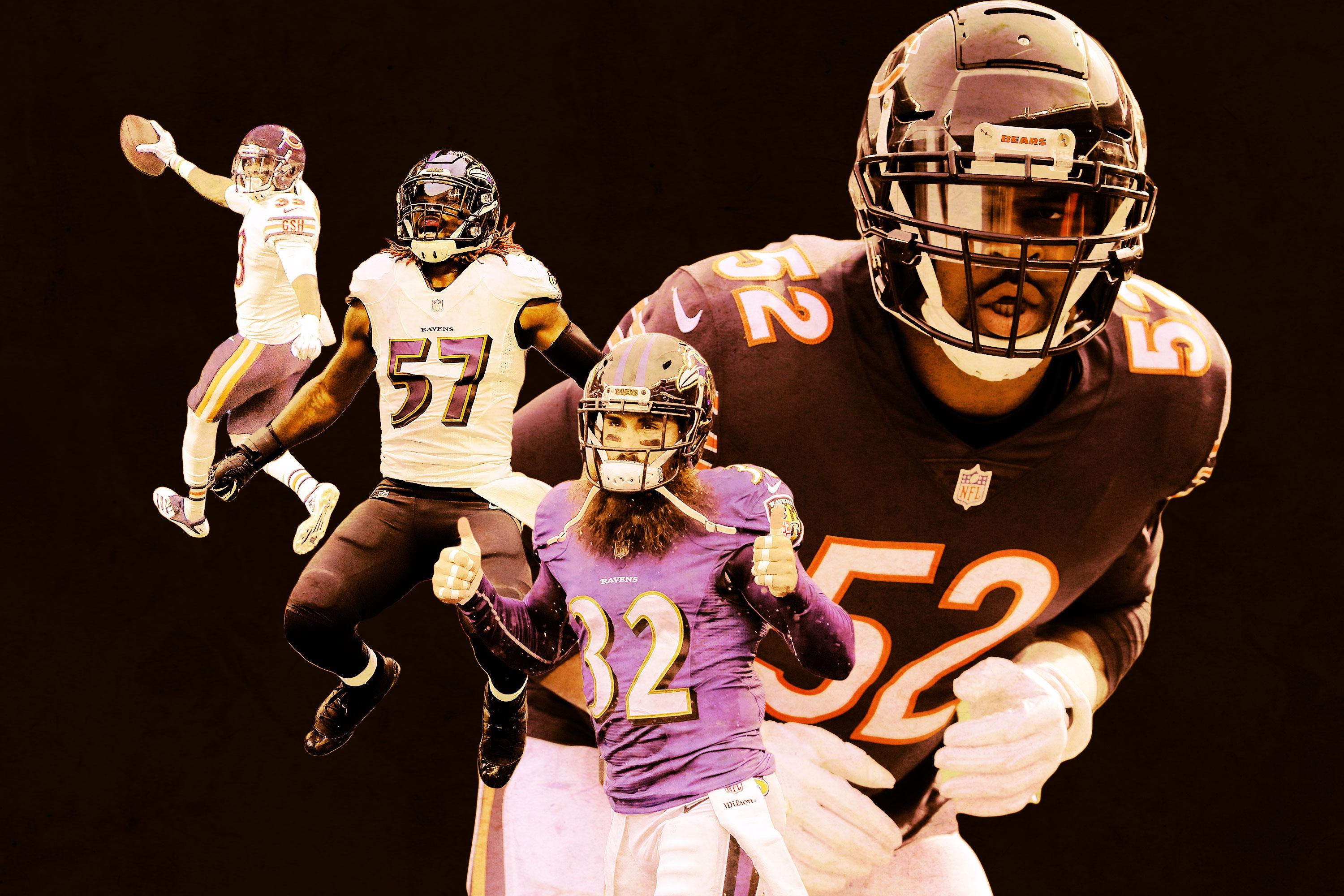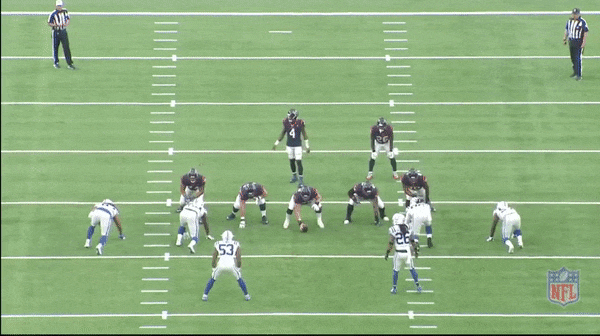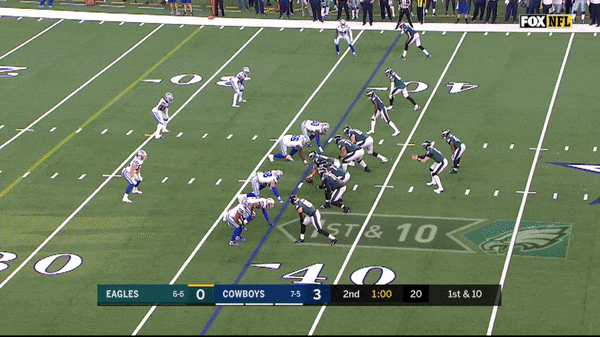The Starting 11: The Bears and Ravens Proved That Defense Isn’t Dead Yet
While 2018 has been characterized by offensive explosions around the league, Chicago’s and Baltimore’s defenses showed on Sunday that even the league’s best offenses can be slowed. Plus: Amari Cooper’s ridiculous run in Dallas continues, and George Kittle has put the 49ers on his back.
Welcome to the Starting 11. This NFL season, we’ll be collecting the biggest story lines, highlighting the standout players, and featuring the most jaw-dropping feats of the week. Let’s dive in.
1. By holding the Rams to single digits in a 15-6 win on Sunday night, the Bears used their prime time slot to prove that defense isn’t dead yet. Defensive coordinator Vic Fangio’s unit dominated Sean McVay’s typically high-scoring offense in just about every way imaginable. Jared Goff was picked off four times and completed just 45 percent of his attempts while barely averaging 4.0 yards per attempt. He was sacked three times and hit eight times total, which included a third-quarter strip sack by Khalil Mack. Todd Gurley was also held in check, as he rushed for just 28 yards on 11 carries. It was about as complete a defensive performance as a team could muster in any era, let alone in the NFL’s current, offense-friendly iteration.
Both quarterbacks made plenty of mistakes during the game, but where Mitchell Trubisky’s three interceptions resulted from ugly overthrows, Goff’s errors were forced. Roquan Smith’s pick in the first quarter came after defensive end Jonathan Bullard shoved left tackle Andrew Whitworth back onto Goff’s foot as he released the ball. On Goff’s third interception, Akiem Hicks created pressure in the middle of the pocket, and Kyle Fuller made an excellent break to come away with the ball. Chicago forced four turnovers on the day, and that total could have been even higher had a tipped pass by Prince Amukamara been corralled by Smith in the second quarter, or had the Bears been able to recover the ball after Mack’s strip sack. Fangio’s unit has a league-leading 34 takeaways on the season, which includes a mind-boggling 25 interceptions in 13 games. No other team in the league has more than 19 picks.
Relying on turnovers to that degree may seem like a dubious formula moving forward, but the Bears aren’t simply happening upon these plays. With their combination of a relentless pass rush, complex zone schemes that incorporate man concepts, and a collection of opportunistic defensive backs who are often put in position to take the ball away, this group is able to consistently wreak havoc on opposing offenses.
Considering Trubisky’s struggles and Chicago’s occasional issues on offense — which also showed up against the Rams — it’s reasonable to wonder whether the Bears can stick with the league’s best offenses in a playoff shootout. But Sunday served as a reminder that, with this defense, they may not have to. Fangio’s group is both talented and expertly schemed, and it’s capable of dictating games no matter who the Bears are playing.
2. Baltimore failed to knock off the Chiefs, losing 27-24 in overtime, but the Ravens defense showed that top units on that side of the ball have a chance against Kansas City’s juggernaut offense. Patrick Mahomes II may have finished with 377 yards passing, but he averaged just over 7.0 yards per attempt on the day. The Ravens kept the Chiefs’ star under pressure all game with a mix of exotic disguises on their blitzes and straightforward one-on-one victories up front. Defensive end Matthew Judon made his presence felt all game, but he was far from the only one getting after Mahomes on Sunday. The Ravens recorded 15 quarterback hits, and even when they weren’t getting home, Mahomes was consistently forced off his spot and had his timing interrupted. Through the contest’s first 58 minutes, the Ravens allowed just 17 points to a team averaging more than 36 per game. If not for a desperation heave to Tyreek Hill on fourth-and-9 late in the game, Baltimore would have come away with one of the most impressive wins of the entire season.
The defense deserves most of the credit for hanging with the Chiefs, but Baltimore has also settled into a nice groove with a throwback offense unlike any in the NFL. Rather than trying to force rookie quarterback Lamar Jackson into a system that doesn’t fit his skill set, the Ravens have built a scheme that plays to his strengths. An overwhelming majority of the team’s plays include some sort of jet motion across the formation, followed by a prolonged mesh between Jackson and a running back. The motion both shifts and freezes linebackers on the second level, while the threat of Jackson keeping the ball allows Baltimore to change the numbers game in the box any time a run is called. Jackson’s work as a passer is secondary to his influence on the run game — both as a ball carrier and a decoy — but the Ravens mix in enough play-action elements to get chunk gains through the air as well.
The only place Baltimore lost on Sunday was the scoreboard. The team’s performance on the road, against arguably the best team in the NFL, bodes well for the Ravens’ chances to create some chaos in the AFC playoffs.
3. Sunday’s game might not have featured the top statistical output of Mahomes’s season, but it was the best example yet of how his brilliance can carry the Chiefs if and when their scheme breaks down. Mahomes’s no-look pass late in the second quarter has garnered a lot of attention in the past 24 hours, but it was just one of the many magnificent throws he had to summon on a day where Kansas City’s offense wasn’t humming. On a third-and-8 about midway through the first quarter, Mahomes placed a perfectly thrown touch pass to Travis Kelce that dropped in just over the trailing linebacker and in front of the safety to keep the Chiefs’ first touchdown drive alive. And on the play immediately following his no-look masterpiece, Mahomes escaped left in the pocket before slinging a sidearm throw at an impossible angle to Spencer Ware running up the left sideline. And let’s not forget the heave to Hill in the game’s final moments that set up the tying score.
Mahomes has been incredible this entire season, but Andy Reid’s offense also does plenty to boost its quarterback. No team in the league gets more separation for its receivers, on average, than Kansas City, and that’s been a characteristic of this unit for years. We’re only a season removed from Alex Smith piloting a Chiefs offense that finished fourth in DVOA and sixth in points per game.
As the MVP debate has waged on throughout the season, the main point used to argue for Drew Brees has been that Brees shoulders more of the burden within the Saints offense than Mahomes does in Kansas City’s. That’s why Sunday’s performance was so telling. When elements of Reid’s scheme broke down, Mahomes was able to conjure plays on his own. His historic statistical pace this season has been a combination of a well-devised offense and his prodigious physical ability, but against the Ravens, Mahomes showed that even on their own, his gifts are enough to overcome one of the league’s top defenses. It was an awe-inspiring display, and it left little doubt about who deserves to be the MVP frontrunner through 14 weeks.
4. While Mahomes spent Sunday showing what he could do outside his system, Jared Goff showed that he still struggles when asked to do the same. Typically, McVay’s offense relies on a healthy dose of play action that creates space for Goff and aids the Rams offensive line in pass protection. But against the Bears, the Rams strayed from their typical game plan. Faced with fewer advantageous down-and-distance scenarios because of their lack of success on first and second down, the Rams used play-action on just 11 of Goff’s 48 dropbacks against Chicago — considerably less than their season average of 36 percent. Goff finished the game just 15 of 34 with a brutal 3.9 yards per attempt on his throws without play-action. It was a stark contrast to the performance Mahomes had against Baltimore, and for the second game in a row, it showed that Goff can struggle when the Rams are forced out of their comfort zone.
5. Amari Cooper’s comments about the Cowboys’ in-game adjustments point both to the potential of the Dallas passing game and to its shortcomings. Late Sunday, RJ Ochoa of Blogging the Boys posted Cooper’s description of how his 75-yard touchdown late in the fourth quarter came to be, and his analysis provides a fascinating window into the Cowboys offense. Apparently, Cooper was supposed to run a stop route on the play, and he was initially frustrated because the Eagles corners had been sitting on that exact concept all game. The Cowboys’ route combinations can be pretty predictable, as evidenced by Cooper’s reaction when he was asked to run yet another route that he didn’t think would work. But Cooper and QB Dak Prescott made a subtle adjustment to the play — Cooper ran a straight go route instead, and the result shows the dimension Cooper has brought to this offense. He gives Dallas another gear in the passing game, but too often, the team’s scheme doesn’t put its players in the right positions. Eagles cornerback Rasul Douglas clearly knew a slant was coming on Prescott’s final touchdown pass to Cooper in overtime, to the point that Douglas was inches away from picking off the ball and turning that score into a game-swinging interception. With the design limitations of this passing game, that’s how slim the margins can be.
6. After a relatively slow start to the season, the Andrew Luck-T.Y. Hilton connection is heating up, and it’s given the Colts already-effective offense an entirely new element. Luck spent the early part of the season picking apart the underneath areas of the field on short throws and using his tight ends as part of a ball-control passing game, but in Sunday’s 24-21 win over the Texans, the deep-ball laser from years past was back in full force. Hilton finished the game with four receptions of at least 28 yards, including a picture-perfect 60-yard gain on a hard play-action fake about midway through the second quarter. That type of slow-developing deep shot is the kind of play the Colts leaned on too often early in Luck’s career, which led to Luck taking far too many hits. But by using max protection and trusting Hilton to win his routes, the Colts can take advantage of Hilton’s speed without putting Luck in harm’s way. If Indianapolis can string together a couple of those bombs a game, defenses are in serious trouble.
7. The Patriots’ 34-33 loss to the Dolphins was a dizzying mix of encouraging signs for New England and uncharacteristically poor situational decision-making from the team’s leaders. Tom Brady was sacked by Robert Quinn late in the first half, and on that play Brady displayed a lack of awareness we almost never see from the Patriots’ legend. New England was in field goal range at the time, but Brady, instead of sensing the pressure and getting rid of the ball, took the sack and knocked his team out of range. Coupled with Bill Belichick’s decision to put Rob Gronkowski on the field as a deep safety on the Dolphins’ game-winning hook-and-ladder play, it was a surreal day for a team that’s typically spotless in high-leverage moments.
That being said, Brady looked sharp for the majority of the first half; his touchdown passes to Julian Edelman and Cordarrelle Patterson were both pinpoint throws in or near the red zone, and his touchdown toss to Gronkowski late in the second quarter was dropped into the only spot where neither the linebacker nor the safety could break up the play. Gronk had an impact throughout the game as he put up his best performance of the season (eight catches for 107 yards and a touchdown). A locked-in Brady and a relevant Gronkowski are both welcome sights for New England as the Pats head into the playoffs, but overall, Sunday was still a strange day for Belichick’s team.
8. George Kittle was an absolute monster for the 49ers on Sunday, and his 85-yard touchdown was the perfect illustration of what he and Kyle Shanahan are capable of creating together. Kittle was unstoppable in the Niners’ 20-14 win over the Broncos, racking up more than 200 receiving yards in the first half as he steamrolled the Denver secondary. His biggest chunk gain came on a gorgeous over route design where Shanahan used a deep post to clear the backside safety. With Kittle running wide open, all Nick Mullens needed to do was drop a pass into a sea of grass and let Kittle do the rest. Shanahan has long been able to scheme his tight ends open on play-action shots like this, and when that tight end happens to be a guy with Kittle’s physical gifts, the results are almost unfair.
9. Several different teams had success with overload defensive back blitzes in key moments on Sunday. Midway through the second quarter of the Packers’ 34-20 win over the Falcons, Green Bay turned a DB blitz into a 22-yard interception return by Bashaud Breeland. The Colts also used a heavy blitz to free cornerback Kenny Moore for a third-down sack in the first quarter of their win over the Texans. With offenses moving the ball down the field with more ease than ever, it wouldn’t be surprising to see more and more defenses force the issue with exotic blitz packages.

10. This week’s line-play moment that made me hit rewind: Tyrone Crawford’s strip sack late in the second quarter helped ruin a likely scoring drive for the Eagles, and it seems like every Cowboys defensive linemen has gotten into the act lately. On this play, Crawford was supposed to act as the decoy — instead, he finished off his line stunt with one final burst that allowed him to knock the ball loose from Carson Wentz. Along with Demarcus Lawrence’s excellent day, it was the second straight week that the Dallas front four has controlled the game.

11. This week in NFL players, they’re absolutely nothing like us: Patrick Mahomes II is an actual wizard.